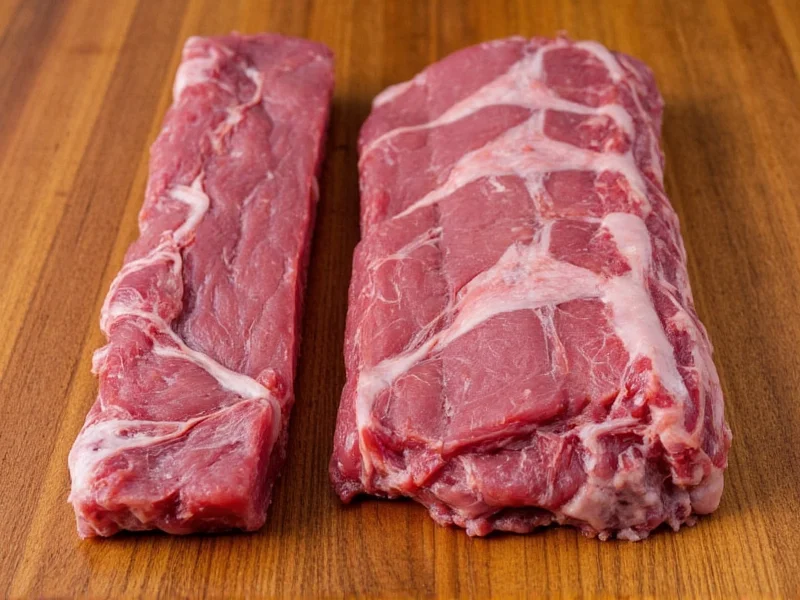When planning your next barbecue or family dinner, understanding the size differences between beef ribs and pork ribs is crucial for proper meal planning, cooking time estimation, and budgeting. The substantial size variation between these two popular rib options affects everything from preparation to serving sizes, making it essential knowledge for home cooks and grill masters alike.
Beef Ribs: Size Characteristics
Beef ribs come in several cuts, but the most common varieties are back ribs and short ribs. Back ribs (also called beef back ribs or dinosaur ribs) typically feature 7-12 substantial bones per rack. Each individual rib measures approximately 8-12 inches in length with a bone diameter of 1-1.5 inches. The meat layer surrounding the bone ranges from 1-2 inches thick, creating a substantial meat-to-bone ratio.
A full rack of beef back ribs usually weighs between 1.5-2.5 pounds, though competition-style "dino ribs" can exceed 3 pounds each. The bones themselves are noticeably curved and substantial, requiring longer cooking times due to their density and size. When comparing beef ribs vs pork ribs size specifications, the difference in bone structure is immediately apparent—beef ribs have much thicker, more robust bones that require specialized cooking techniques.
Pork Ribs: Size Characteristics
Pork ribs come in three main varieties: baby back ribs, spare ribs, and St. Louis style ribs. Baby back ribs (also called loin ribs) are the smallest variety, with each rack containing 10-13 curved bones measuring 4-6 inches in length. The bone diameter is significantly smaller at just 0.5-0.75 inches, with a meat layer of approximately 0.5-1 inch thick.
A typical rack of baby back ribs weighs 1-1.5 pounds, while spare ribs (which include the belly portion) are slightly larger at 2-3 pounds per rack but still feature the same smaller bone structure. When considering pork rib rack size versus beef rib rack measurements, the difference becomes clear—pork ribs offer more individual bones per rack but with substantially less meat per bone.
Direct Size Comparison: Beef Ribs vs Pork Ribs
The most noticeable difference in beef ribs vs pork ribs size is immediately visible when placed side by side. Beef ribs feature dramatically larger bones with more substantial meat coverage, while pork ribs have more delicate bones with a thinner meat layer. This size difference directly impacts cooking methods, serving sizes, and overall meal planning.
| Measurement | Beef Ribs | Pork Ribs |
|---|---|---|
| Rack Length | 8-12 inches | 4-7 inches |
| Rack Weight | 1.5-2.5 lbs | 1-1.5 lbs (baby back) |
| Bone Diameter | 1-1.5 inches | 0.5-0.75 inches |
| Meat Thickness | 1-2 inches | 0.5-1 inch |
| Bones per Rack | 7-12 | 10-13 (baby back) |
| Visual Profile | Bulky, meaty, substantial | Slender, curved, delicate |
Practical Implications of Size Differences
The size disparity between beef ribs and pork ribs has several practical consequences for cooks and consumers. When comparing beef ribs dimensions versus pork ribs, the cooking time difference is significant—beef ribs typically require 5-7 hours of low-and-slow cooking, while pork ribs need 4-6 hours. This extended cooking time for beef ribs vs pork ribs size considerations is necessary to properly render the substantial amount of connective tissue in the larger cut.
Serving size expectations also differ considerably. A single beef rib can serve as a substantial main course for one person, while pork ribs typically require 2-3 bones per serving. When meal planning for a group, this means you'll need fewer beef ribs than pork ribs to feed the same number of people. For example, when determining how big are beef ribs compared to pork ribs in practical terms, four beef ribs might feed two people, while you'd need 6-8 pork ribs for the same serving.
The size difference also affects cost calculations. While beef ribs often have a higher price per pound, their greater meat content means the cost per serving might be more comparable than the sticker price suggests. Understanding pork rib portion size versus beef ribs helps consumers make more informed purchasing decisions based on actual edible meat rather than just the raw weight.
How to Identify Rib Types by Size
When shopping for ribs, size provides the most immediate clue to distinguish between beef and pork varieties. Beef ribs feature noticeably thicker bones with substantial meat coverage that extends well beyond the bone structure. The bones themselves have a more pronounced curve and feel substantially heavier in hand.
Pork ribs, by contrast, have more delicate bones with a thinner layer of meat. Baby back ribs show a distinctive arch shape, while spare ribs have a flatter profile with more irregular bone structure. When comparing size difference between beef back ribs and pork spare ribs, the beef variety will always appear substantially larger and more robust.
At the grocery store, packaging labels can sometimes be confusing, but the physical size provides a reliable indicator. If the individual ribs measure less than 7 inches and the bones feel relatively thin, you're likely looking at pork ribs. If the ribs exceed 8 inches with thick, substantial bones, you've found beef ribs. This knowledge proves particularly valuable when shopping at butcher counters where labeling might be minimal.
Conclusion
Understanding the size differences between beef ribs and pork ribs is essential for successful meal planning and cooking. Beef ribs offer larger portions with more substantial meat coverage but require longer cooking times, while pork ribs provide more delicate portions that cook slightly faster. When considering beef ribs vs pork ribs size for your next barbecue, factor in your guest count, cooking equipment limitations, and desired presentation to make the best choice for your specific needs.











 浙公网安备
33010002000092号
浙公网安备
33010002000092号 浙B2-20120091-4
浙B2-20120091-4